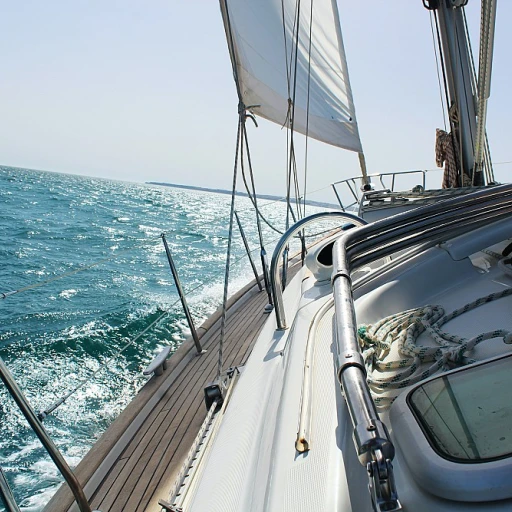Understanding Lake Conditions
Understanding Your Surroundings: A Key To Success On The Water
Choosing the ideal anchor for lake boating requires more than a simple purchase. Understanding the lake conditions you plan to navigate is crucial in making an informed decision. Factors such as water depth, current, wind, and the nature of the lake bottom can all affect your anchor's performance.
Lakes often present a variety of bottom types, from soft bottoms like sand and mud to more challenging rocky bottoms. Each type of sea bed requires a different anchor to achieve optimal holding power. For instance, a fluke anchor might excel in sandy or muddy environments due to its flat design and ability to dig in. Meanwhile, a mushroom anchor could be more suited to soft, weedy bottoms where its weight and shape offer enhanced stability.
The right anchor will efficiently hold your boat in place, even in conditions with stronger currents or winds. Considering the
appropriate anchor chain size can significantly improve your anchor's holding score, ensuring your boat remains secure without drifting away or causing unnecessary strain on your equipment.
Being aware of the specific conditions can prevent inconvenient messages from other boaters or rescue teams. Therefore, before setting off, spend time evaluating the common weather patterns and the typical stroke width of the area you plan to anchor. This forethought, coupled with a well-chosen anchor and strategy, will significantly improve your boating experience.
Types of Anchors Suitable for Lakes
Exploring Various Anchor Types for Lake Use
When it comes to selecting an anchor suitable for lake boating, understanding the various types available is a vital step. Here's a closer look at some popular options that may be the best fit for your boat depending on the lake conditions you encounter.
-
Plow Anchor: Known for its distinct design, the plow anchor is ideal for rocky bottoms or when the lake's bottom composition is uncertain. Its strong holding power helps provide security in diverse conditions.
-
Danforth Anchor: Flaunting a traditional design, the Danforth anchor is perfect for sand and soft bottoms, like those often found in lakes. Its flukes dig into the bottom, offering excellent holding.
-
Mushroom Anchor: This type is great for small boats due to its compact shape. It works well in lakes where the bottom is soft and muddy since its "mushroom" head can fill with bottom materials to achieve a high holding score.
-
Box Anchor: A versatile option, the box anchor can adapt to various lake bottoms and needs minimal stroke width to deploy effectively. It’s known for requiring less scope, which means it can hold your boat firmly without the need for long lines.
While this list highlights some well-regarded options, choosing the right boat anchor involves considering your boat's size and weight, the lake conditions, and personal preferences. If you're looking to deepen your understanding of how different engines or propulsion systems influence your boating experience, take a look at exploring the power of Mercury's 6 HP Outboard. Understanding your boat's propulsion can also impact your anchor choices and deployment techniques.
Material Considerations for Lake Anchors
Evaluating Anchor Materials for Lake Boating
Understanding the material composition of an anchor can significantly impact your boating experience on a lake. Choosing the right material not only affects the anchor's holding power but also its weight and durability. When it comes to lake boating, selecting the appropriate material is essential to ensure your boat remains securely in place.
Different materials offer varying levels of strength and resistance to environmental factors, such as water and constant contact with the bottom. Here's a brief overview of common materials used for lake anchors and their associated benefits:
- Galvanized Steel: This is a popular choice due to its durability and resistance to rust. It provides excellent holding power, especially in rocky bottoms, and is an optimal choice for longer use.
- Stainless Steel: Known for its aesthetic appeal and resistance to corrosion, stainless steel anchors tend to come with a higher regular price. They provide great strength and are an excellent choice if you prioritize performance and longevity.
- Aluminum: Lightweight yet strong, aluminum anchors like the box anchor and digger anchor are ideal if you frequently relocate your boat. They offer good holding power although it might not be as effective on rocky bottoms.
- Composites and Plastics: Some anchors are made from high-strength composites or plastics. These materials are typically used in mushroom or fluke anchors and are excellent if you're dealing with soft bottoms, like sand mud, where depth and penetration are essential.
Selecting the best anchor material depends on several factors including the boat size, boat length, and the water conditions of the lake. Understanding these nuances will help ensure that your anchor will perform well under various conditions, providing the security and peace of mind you need when boating on lakes.
Using the appropriate material for your anchor not only scores well in terms of functionality but also enhances the overall reaction of your anchor to the lake's unique conditions, thus optimizing your lake boating experience. For more insights on anchoring techniques and their impact, you can explore
mastering the art of using a sand anchor for yachts as referenced in understanding the types of anchors suitable for lake boating.
Weight and Size: Finding the Right Balance
Balancing Weight and Size for Optimal Anchor Performance
When selecting an anchor for lake boating, it's crucial to find the right balance between weight and size to ensure your boat remains secure on the water. The weight of an anchor affects its ability to penetrate the lake's bottom and achieve strong holding power. However, heavier isn't always better; the reaction score should guide you in choosing the one that suits your boat's specific needs.
Different boats will require different anchor weights to hold effectively. Consider your boat's size and length when choosing an anchor. A larger boat generally requires a heavier anchor, while smaller boats can manage well with lighter options. The holding power of the anchor should match the conditions of your chosen location, like soft sandy bottoms or rocky terrains.
Common anchor types such as the fluke anchor have a good hold on sand and mud. The plow and box anchor excel in various lake bottom conditions by adjusting their stroke width and increasing their penetration.
If weight is a concern, especially for smaller boats, consider the mushroom anchor. It's compact and ideal for consistent soft bottoms, like sand or mud, where it can securely dig in and hold. Meanwhile, the digger anchor offers a good stroke that holds firm in rocky bottoms by adjusting its position as water and depth conditions change.
Utilizing anchors deliberately suited for specific lake conditions ensures not only the safety of your boat but also enhances your boating experience by minimizing issues such as drift or poor holding. Regular evaluations of your anchor's reaction to different environments can lead to more judicious choices and safer boating adventures.
Anchor Deployment Techniques
Anchor Deployment Techniques for Optimal Hold
Deploying an anchor effectively is as crucial as choosing the right type and material. It's essential to ensure that the anchor's holding power is maximized, no matter the lake's bottom conditions, such as soft sand or rocky beds. Here are some tips and techniques to ensure your anchor will dig in and hold well:
- Assess the Bottom Conditions: Before dropping your anchor, assess the water location. Knowing whether you're dealing with sand, mud, or rocky bottoms can influence how to set the anchor and which type, such as a plow anchor or box anchor, might score better in terms of holding power.
- Selecting the Right Phase: Depending on your boat size and weight, choosing an anchor that matches your boating needs is vital. Factors like boat length dictate how much scope (the ratio of anchor line to the water depth) is required for optimal hold.
- Digging in Properly: To achieve the best hold especially in soft bottoms, lower your digger anchor or fluke anchor carefully to the lake bottom. Allow the boat to gently drift backward so the anchor digs in, securing with a slight pull. In conditions with more resistant rocky bottoms, a heavier Danforth anchor might provide better holding.
By understanding how to properly deploy the anchor, a vessel can maintain its desired position despite changing water conditions or sudden shifts in wind direction. Regularly testing your anchor’s performance can lead to more confident boating experiences. Keeping these deployment techniques in mind, boaters can enhance their anchor’s reaction score significantly, reducing unintended drifts.
Maintenance and Storage of Lake Anchors
Proper Care and Storage Techniques
Proper maintenance and storage of your boat anchor are paramount in ensuring it remains functional and reliable for lake boating. Here are some guidelines to help keep your anchor in top shape:
- Cleaning Your Anchor: After each use, rinse your anchor with fresh water to remove any debris or sediments, especially when used on sandy or rocky bottoms. This prevents corrosion and keeps you from dragging unwanted material to your next location.
- Inspection: Regularly check your anchor for signs of wear and tear. This includes assessing the holding power of parts like the shank, fluke, or any stroke components in plow, fluke, or danforth anchors.
- Storage Solutions: Stow your anchor in a dry, ventilated area to avoid rust, especially those made from metals that might react negatively with moisture. A well-kept box anchor or mushroom anchor will retain its strength and reliability longer.
- Anchor Line Care: Maintenance doesn't stop with the anchor; the line is equally important. Inspect it for fraying or damage and replace when needed. Securely coil the line to prevent tangling.
- Routine Checks: Periodically test your anchor's holding capability in a controlled environment to ensure that it will perform when needed. Different bottoms like sand, mud, or rocky will influence your test result.
By dedicating a little time to anchor maintenance, you'll enhance its longevity and performance, ensuring peace of mind the next time you anchor your boat on the lake. Remember, the best strategy is proactive care, saving you from potential mishaps on your nautical adventures.

